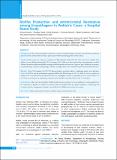Please use this identifier to cite or link to this item:
https://hdl.handle.net/20.500.14356/1566| Title: | Biofilm Production and Antimicrobial Resistance among Uropathogens in Pediatric Cases: a Hospital Based Study |
| Authors: | Shrestha, Dhiraj Thapa, Pratigya Bhandari, Dinesh Parajuli, Hiramani Chaudhary, Prakash Thapa, Kabi Sharma, Vijay Kumar Shah, Pradip Kumar Shah |
| Citation: | ShresthaD., ThapaP., BhandariD., ParajuliH., ChaudharyP., ThapaK., SharmaV. K., & ShahP. K. (2018). Biofilm Production and Antimicrobial Resistance among Uropathogens in Pediatric Cases: a Hospital Based Study. Journal of Nepal Health Research Council, 16(2), 178-183. https://doi.org/10.33314/jnhrc.v16i2.921 |
| Issue Date: | 2018 |
| Publisher: | Nepal Health Research Council |
| Article Type: | Original Article |
| Keywords: | AMR Antimicrobial resistance Biofilm Urinary tract infection UTI |
| Series/Report no.: | Apr-June, 2018;921 |
| Abstract: | Abstract Background: The study was designed to provide account of etiological agents of urinary tract infection in pediatric patients and the antimicrobial resistance pattern plus biofilm producing profile of the isolates. Methods: The prospective study was conducted in Alka Hospital, Nepal with 353 clean catch urine samples from children. It was obtained during July 2014 to January 2015 which were first cultured by semi-quantitative method, followed by antimicrobial susceptibility testing and biofilm production assay on Congo red agar. Multidrug- resistance, extensively drug- resistance and pandrug- resistance among isolates were considered as per international consensus. Results: Out of 353 samples, 64 (18.13%) showed positive growth in culture, confirming urinary tract infection. E. coli, 44 (68.8%) was the predominant organism followed by Klebsiella spp. 6 (14.1%). Most E. coli were sensitive to amikacin (93.2%) followed by nitrofurantoin (86.4%), and highly resistant to ampicillin (95.5%). Of 64 isolates, 23 (35.93%) were found to be multidrug- resistant strains. Biofilm was produced by 36 (56.25%) isolates. Conclusions: This study showed higher biofilm production and resistance to in-use antibiotics rendering ineffective for empirical use. Regular surveillance of resistance patterns should be done to regulate multidrug- resistant bugs and to ensure effective management of urinary tract infection in children in a tertiary care setups. Keywords: AMR; antimicrobial resistance; biofilm; urinary tract infection; UTI. |
| Description: | Original Article |
| URI: | http://103.69.126.140:8080/handle/20.500.14356/1566 |
| ISSN: | Print ISSN: 1727-5482; Online ISSN: 1999-6217 |
| Appears in Collections: | Vol. 16 No. 2 Issue 39 Apr-Jun 2018 |
Files in This Item:
| File | Description | Size | Format | |
|---|---|---|---|---|
| 921-Manuscript-5305-1-10-20180703.pdf | Fulltext Download | 330.94 kB | Adobe PDF |  View/Open |
Items in DSpace are protected by copyright, with all rights reserved, unless otherwise indicated.
